1994 CADILLAC SEVILLE traction control
[x] Cancel search: traction controlPage 9 of 399
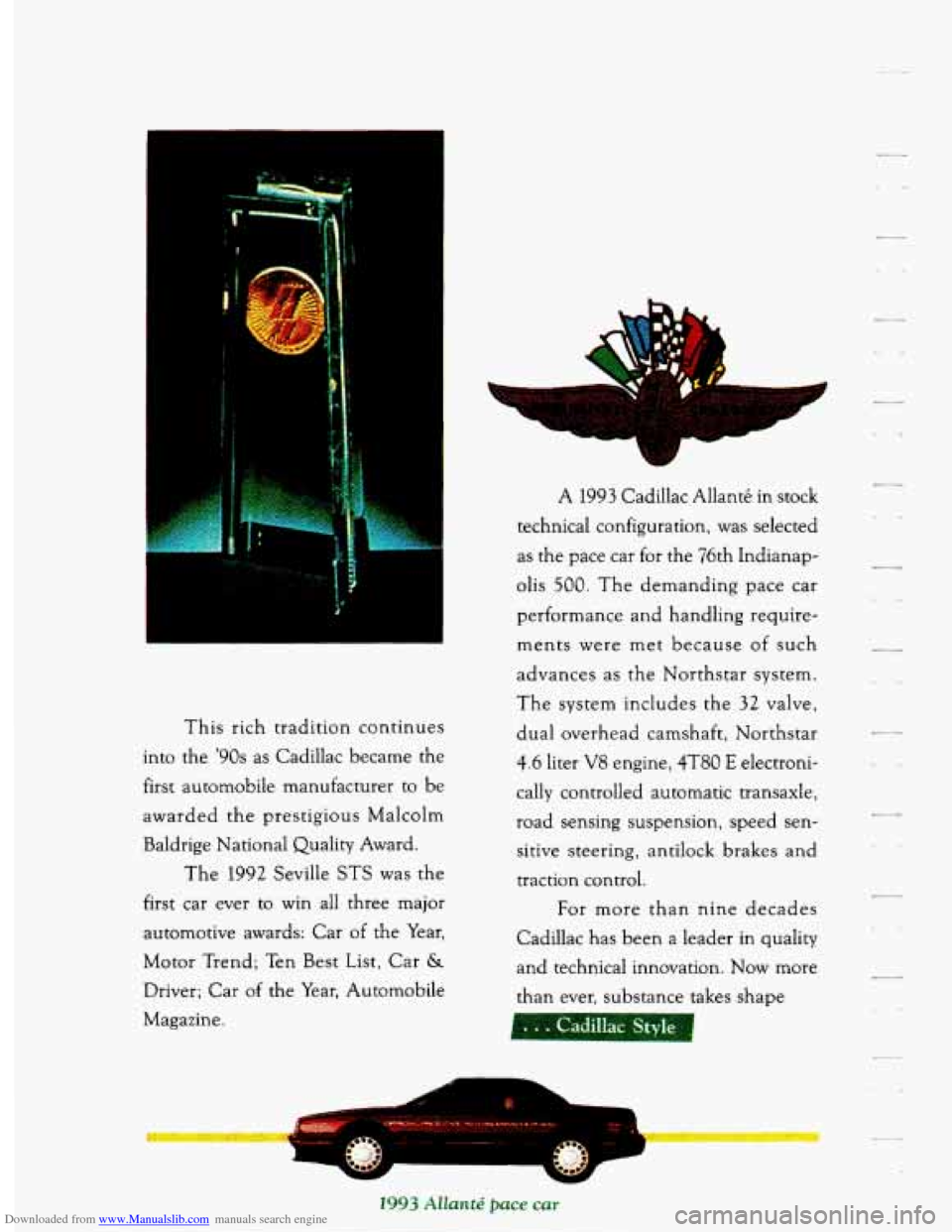
Downloaded from www.Manualslib.com manuals search engine This rich tradition continues
into the
'90s as Cadillac became the
first automobile manufacturer to be
awarded the prestigious Malcolm
Baldrige National Quality Award.
The 1992 Seville
STS was the
first car ever to win all three major
automotive awards: Car of the Year,
Motor Trend; Ten Best List, Car
&
Driver; Car of the Year, Automobile
Magazine.
A 1993 Cadillac Allantk in stock
technical configuration, was selected
as the pace car for the
76th Indianap-
olis
500. The demanding pace car
performance and handling require- ments were met because of such
advances as the Northstar system.
The system includes
the 32 valve,
dual overhead camshaft, Northstar
4.6 liter V8 engine, 4T80 E electroni-
cally controlled automatic transaxle,
road sensing suspension, speed sen-
sitive steering, antilock brakes and
traction control. For more than nine decades
Cadillac has been a leader in quality
and technical innovation.
Now more
than ever, substance takes shape
-
L .&
Page 162 of 399
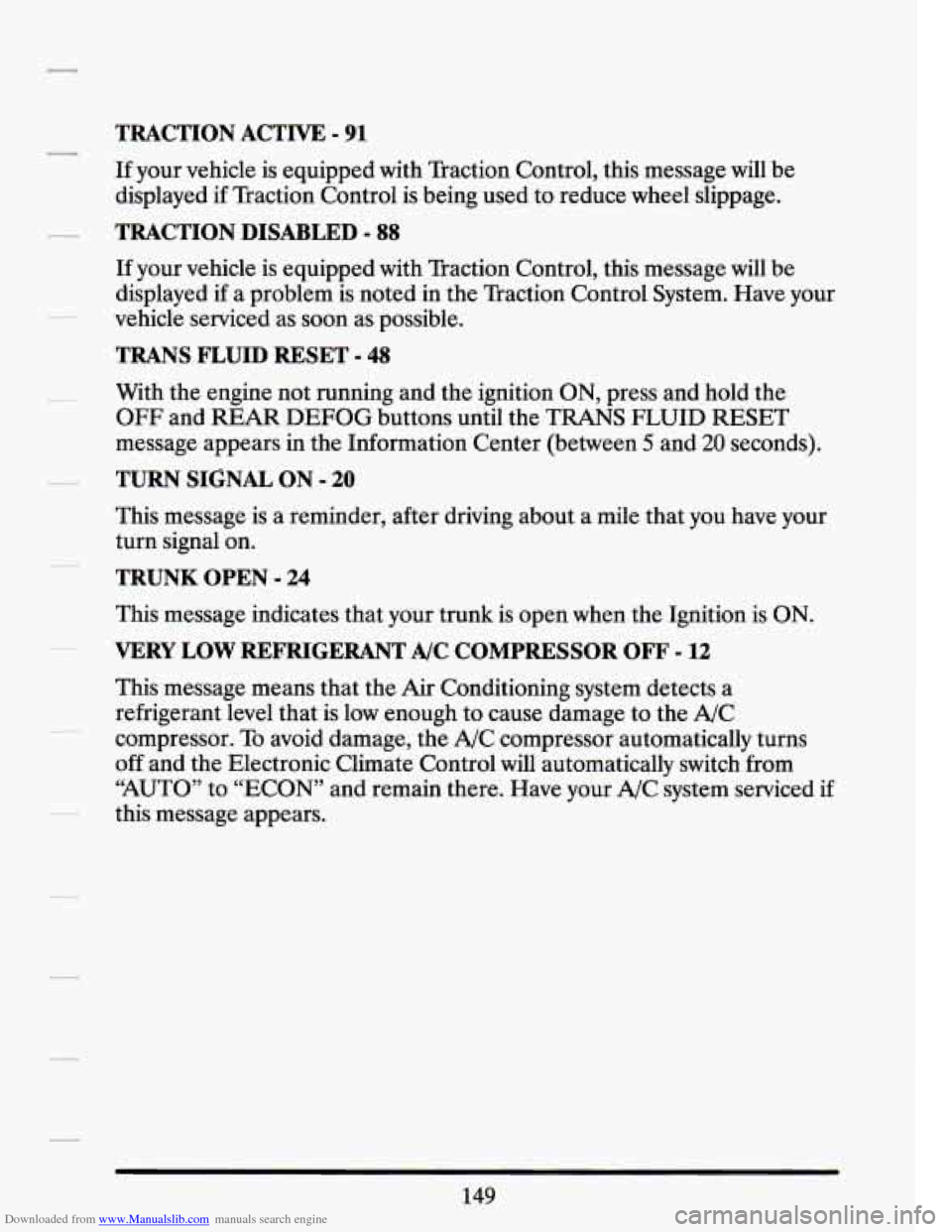
Downloaded from www.Manualslib.com manuals search engine TRACTION ACTIVE - 91
If your vehicle is equipped with Traction Control, this message will be
displayed
if Traction Control is being used to reduce wheel slippage.
TRACTION DISABLED - 88
If your vehicle is equipped with Traction Control, this message will be
displayed if a problem is noted in the Traction Control System. Have your
vehicle serviced as soon as possible.
TRANS FLUID RESET - 48
With the engine not running and the ignition ON, press and hold the
OFF and REAR DEFOG buttons until the TRANS FLUID RESET
message appears in the Information Center (between
5 and 20 seconds).
TURN SIGNAL ON - 20
This message is a reminder, after driving about a mile that you have your
turn signal on.
TRUNK OPEN - 24
This message indicates that your trunk is open when the Ignition is ON.
VERY LOW REFRIGERANT A/C COMPRESSOR OFF - 12
This message means that the Air Conditioning system detects a
refrigerant level that is low enough to cause damage to the A/C
compressor. To avoid damage, the A/C compressor automatically turns
off and the Electronic Climate Control will automatically switch from
“AUTO” to “ECON” and remain there. Have your A/C system serviced if
this message appears.
149
Page 194 of 399
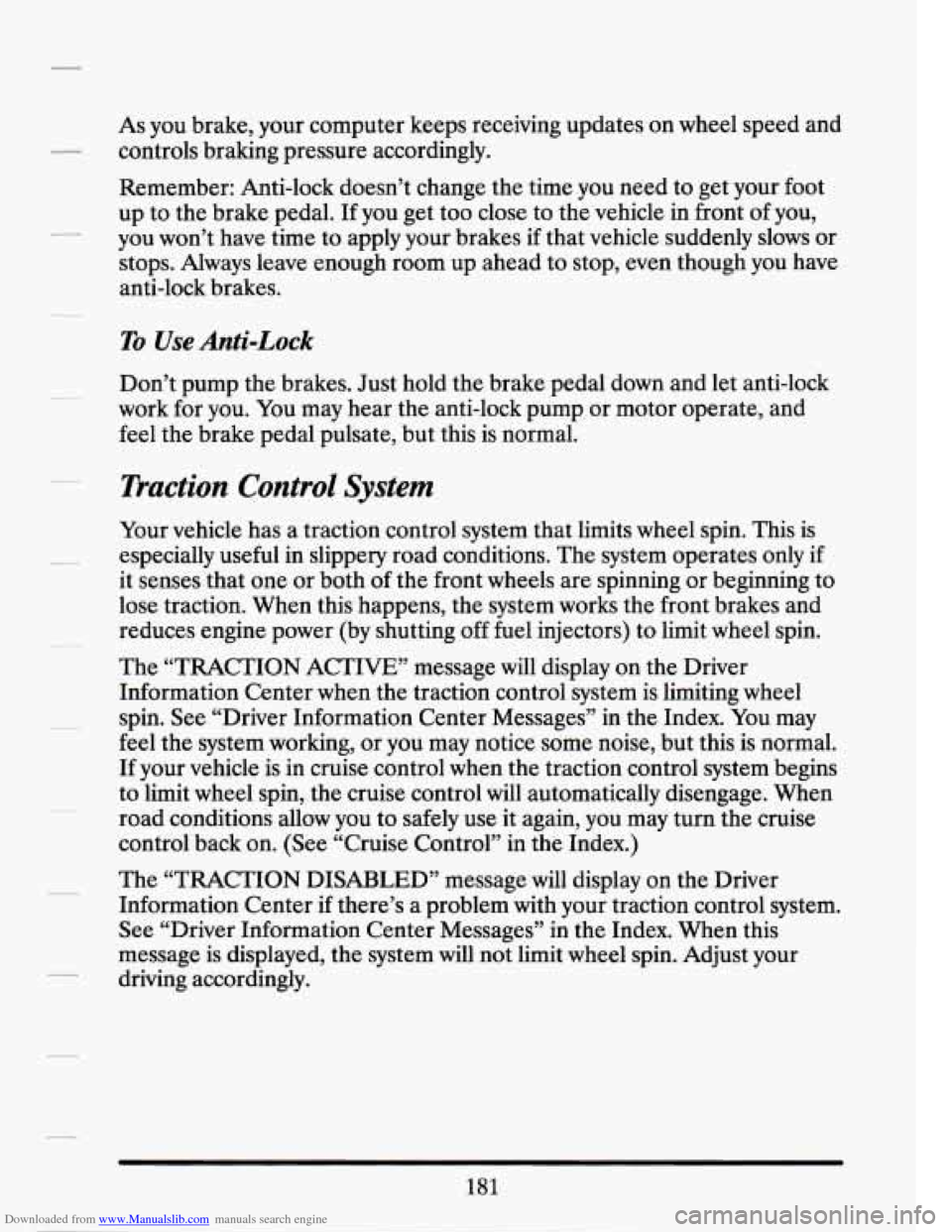
Downloaded from www.Manualslib.com manuals search engine -
As you brake, your computer keeps receiving updates on wheel speea ana
controls braking pressure accordingly.
Remember: Anti-lock doesn’t change the time you need to get your foot
up to the brake pedal.
If you get too close to the vehicle in front of you,
you won’t have time to apply your brakes if that vehicle suddenly slows or
stops. Always leave enough room up ahead to stop, even though you have
anti-lock brakes.
To Use Anti-Lock
Don’t pump the brakes. Just hold the brake pedal down and let anti-lock
work for you. You may hear the anti-lock pump or motor operate, and
feel the brake pedal pulsate, but this is normal.
Traction Control System
Your vehicle has a traction control system that limits wheel spin. This is
especially useful in slippery road conditions. The system operates only if
it senses that one or both
of the front wheels are spinning or beginning to
lose traction. When this happens, the system works the front brakes and
reduces engine power (by shutting off fuel injectors) to limit wheel spin.
The “TRACTION ACTIVE” message will display on the Driver
Information Center when the traction control system is limiting wheel
spin. See “Driver Information Center Messages” in the Index. You may
feel the system working, or you may notice some noise, but this is normal.
If your vehicle is in cruise control when the traction control system begins
to limit wheel spin, the cruise control will automatically disengage. When
road conditions allow you to safely use it again, you may turn the cruise
control back on. (See “Cruise Control” in the Index.)
The “TRACTION DISABLED” message will display on the Driver
Information Center
if there’s a problem with your traction control system.
See “Driver Information Center Messages” in the Index. When this
message is displayed, the system will not limit wheel spin. Adjust your
driving accordingly.
181
Page 195 of 399

Downloaded from www.Manualslib.com manuals search engine Braking in Emergencies
Use your anti-lock braking system when you need to. With anti-lock, you
can steer and brake at the same time. In many emergencies, steering can
help you more than even the very best braking.
STEERTNG
Power Steering
If you lose power steering assist because the engine stops or the system is
not functioning, you can steer but it will take much more effort.
Steering Tips
Driving on Curves
It’s important to take curves at a reasonable speed.
A lot of the “driver lost control” accidents mentioned on the news
happen
on curves. Here’s why:
Experienced driver or beginner, each of us is subject to the same laws
of
physics when driving on curves. The traction of the tires against the road
surface makes
it possible for the vehicle to change its path when you turn
the front wheels.
If there’s no traction, inertia will keep the vehicle going
in the same direction. If you’ve ever tried to steer a vehicle on wet ice,
you’ll understand this.
The traction you can get in a curve depends on the condition of your tires
and the road surface, the angle at which the curve is banked, and your
speed. While you’re in a curve, speed is the one factor you can control.
Suppose you’re steering through a sharp curve. Then you suddenly
accelerate. Both control systems
-- steering and acceleration -- have to do
their work where the tires meet the road. Unless
you have traction
control and the system is on, adding the sudden acceleration can demand
too much of those places. You can lose control.
182
Page 200 of 399
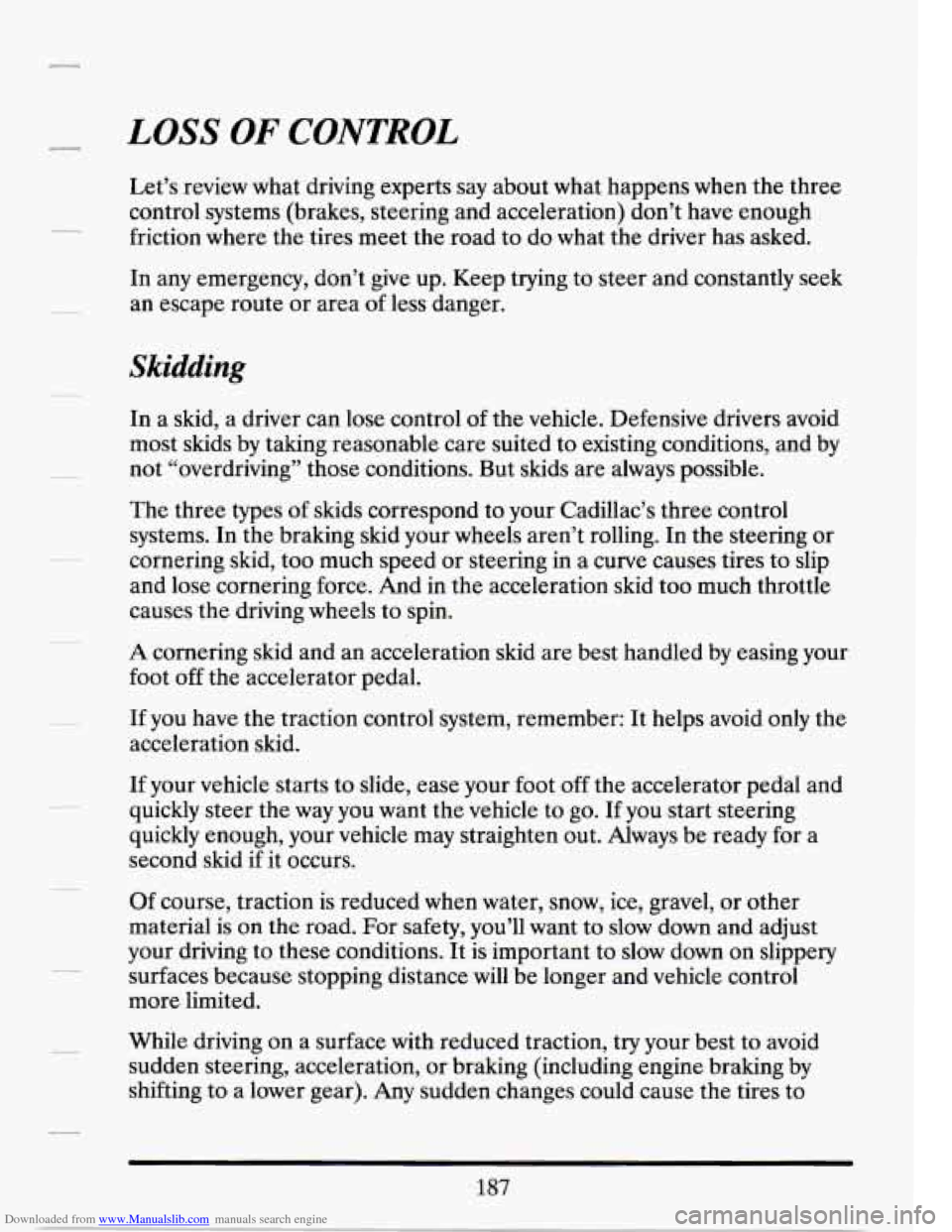
Downloaded from www.Manualslib.com manuals search engine LOSS OF CONTROL
Let’s review what driving experts say about what happens when the three
control systems (brakes, steering and acceleration) don’t have enough
friction where the tires meet the road to do what the driver has asked.
In any emergency, don’t give up. Keep trying to steer and constantly seek
an escape route or area
of less danger.
Skidding
In a skid, a driver can lose control of the vehicle. Defensive drivers avoid
most skids by taking reasonable care suited to existing conditions, and by
not “overdriving” those conditions. But skids are always possible.
The three types
of skids correspond to your Cadillac’s three control
systems. In the braking skid your wheels aren’t rolling. In the steering or
cornering skid, too much speed or steering in
a curve causes tires to slip
and lose cornering force. And in the acceleration skid too much throttle
causes the driving wheels to spin.
A cornering skid and an acceleration skid are best handled by easing your
foot off the accelerator pedal.
If you have the traction control system, remember: It helps avoid only the
acceleration skid.
If your vehicle starts to slide, ease your foot
off the accelerator pedal and
quickly steer the way you want the vehicle to go. If you start steering
quickly enough, your vehicle may straighten out. Always be ready for a
second skid
if it occurs.
Of course, traction is reduced when water, snow, ice, gravel, or other
material
is on the road. For safety, you’ll want to slow down and adjust
your driving to these conditions. It is important to
slow down on slippery
surfaces because stopping distance will be longer and vehicle control
more limited.
While driving
on a surface with reduced traction, try your best to avoid
sudden steering, acceleration, or braking (including engine braking by
shifting to a lower gear). Any sudden changes could cause the tires to
187
Page 213 of 399
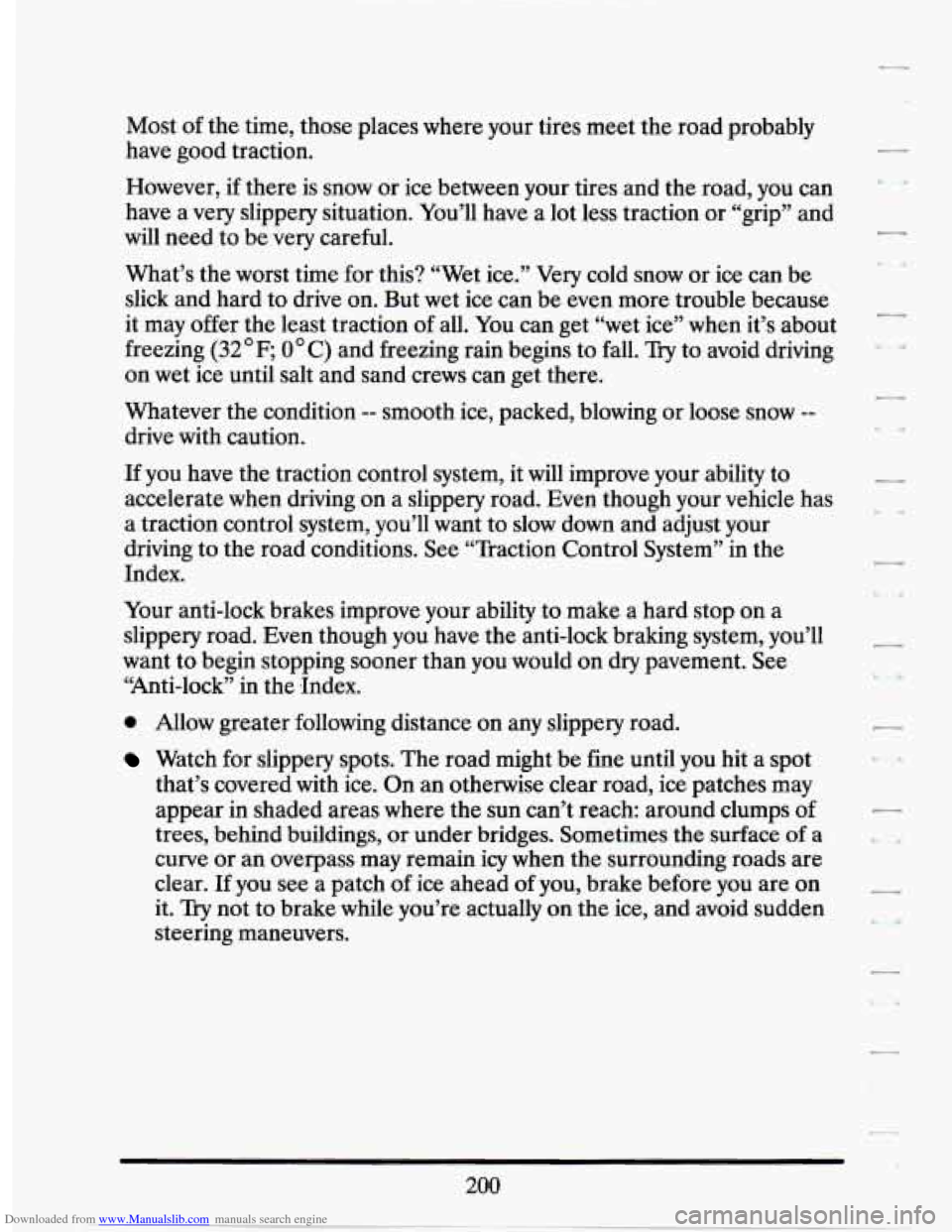
Downloaded from www.Manualslib.com manuals search engine Most of the time, those places where your tires meet the road probably
have good traction.
However, if there is snow or ice between your tires and the road, you can
have a very slippery situation. You’ll have
a lot less traction or “grip” and
will need to be very careful.
What’s the worst time for this? “Wet ice.” Very cold snow or ice can be
slick and hard to drive on. But wet
ice can be even more trouble because
it may offer the least traction
of all. You can get “wet ice” when it’s about
freezing
(32’F; O°C) and freezing rain begins to fall. Try to avoid driving
on wet
ice until salt and sand crews can get there.
Whatever the condition
-- smooth ice, packed, blowing or loose snow --
drive with caution.
If you have the traction control system, it will improve your ability to
accelerate when driving on a slippery road. Even though your vehicle has
a traction control system, you’ll want to slow down and adjust your
driving to the road conditions. See “Traction Control System” in the
Index.
Your anti-lock brakes improve your ability to make a hard stop on a
slippery road. Even though you have the anti-lock braking system, you’ll
want
to begin stopping sooner than you would on dry pavement. See
“Anti-lock” in the Index.
e Allow greater following distance on any slippery road.
Watch for slippery spots. The road might be fine until you hit a spot
that’s covered with ice. On an otherwise clear road, ice patches may
appear in shaded areas where the sun can’t reach: around clumps of
trees, behind buildings, or under bridges. Sometimes the surface
of a
curve or an overpass may remain icy when the surrounding roads are
clear. If you see a patch of ice ahead
of you, brake before you are on
it. Try not to brake while you’re actually on the ice, and avoid sudden
steering maneuvers.
200
Page 308 of 399
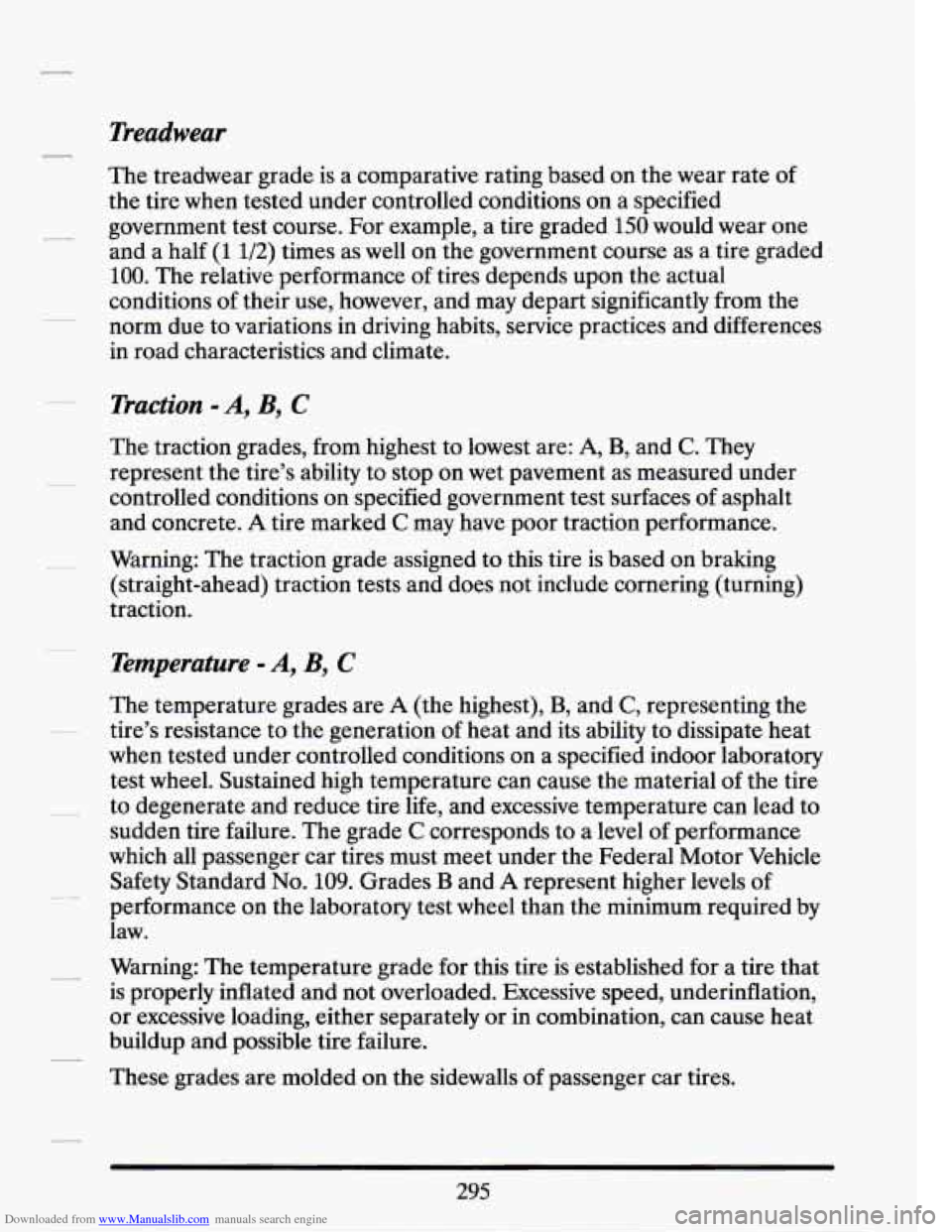
Downloaded from www.Manualslib.com manuals search engine Treadwear
The treadwear grade is a comparative rating based on the wear rate of
the tire when tested under controlled conditions on a specified
- government test course. For example, a tire graded 150 would wear one
and a half
(1 1/2) times as well on the government course as a tire graded
100. The relative performance of tires depends upon the actual
conditions
of their use, however, and may depart significantly from the
norm due to variations in driving habits, service practices and differences
in road characteristics and climate.
-
__
Traction - A, B, C
The traction grades, from highest to lowest are: A, B, and C. They
represent the tire’s ability to stop on wet pavement as measured under
controlled conditions on specified government test surfaces
of asphalt
and concrete.
A tire marked C may have poor traction performance.
Warning: The traction grade assigned to this tire is based on braking
(straight-ahead) traction tests and does not include cornering (turning)
traction.
Temperature -A, B, C
The temperature grades are A (the highest), B, and C, representing the
when tested under controlled conditions on a specified indoor laboratory
test wheel. Sustained high temperature can cause the material of the tire
to degenerate and reduce tire life, and excessive temperature can lead to
sudden tire failure. The grade.C corresponds to a level
of performance
which all passenger car tires must meet under the Federal Motor Vehicle
Safety Standard
No. 109. Grades B and A represent higher levels of
performance on the laboratory test wheel than the minimum required by
law.
-. - tire’s resistance to the generation of heat and its ability to dissipate heat
_- -
Warning: The temperature grade for this tire is established for a tire that
is properly inflated and not overloaded. Excessive speed, underinflation,
or excessive loading, either separately or
in combination, can cause heat
buildup and possible tire failure.
These grades
are molded on the sidewalls of passenger car tires.
~
295
Page 333 of 399

Downloaded from www.Manualslib.com manuals search engine 4T80E Transaxle
The Hydra-Matic 4T80E transaxle has been designed to complement the
output characteristics of the Northstar engine. The innovative design
incorporates several features which enhance its overall operation.
This transaxle is the first
of a new generation of “SMART” transmissions.
The computer which controls the electronic shift solenoids adapts to
changing environments while you drive. This provides consistent high
quality shifts under all conditions. Communication between the engine
and transaxle through this computer controls engine output during
activation
of torque management or traction control. Smooth shifting is
ensured by design. Hydraulic accumulators control shift pressures and all
shifts are made to free wheeling elements.
The 4T80E uses a
dry sump lubrication system with a scavenger pump.
This unique feature er,ables the transaxle to maintain adequate
pressurized oil supply during all maneuvers.
320
l-
l-